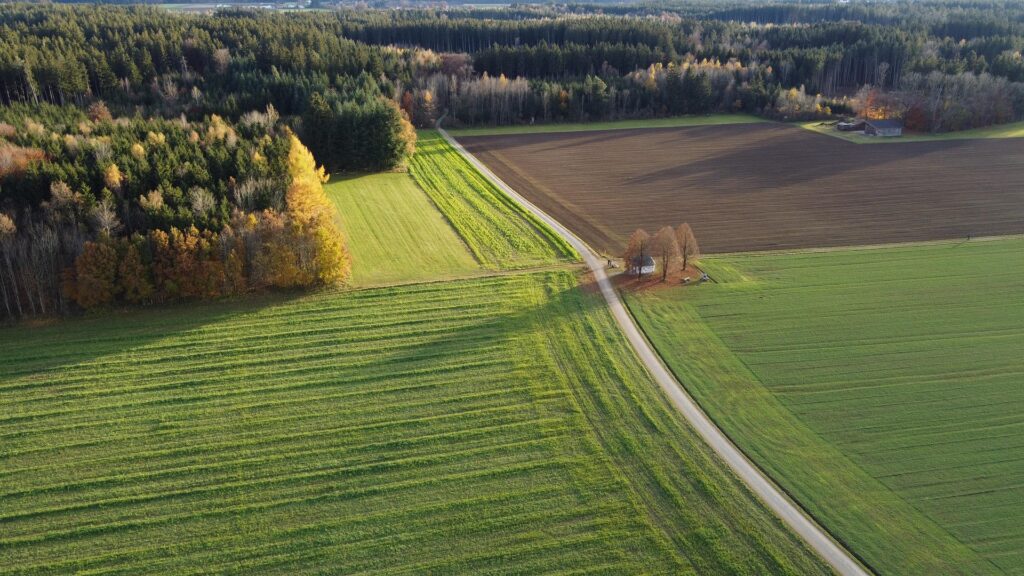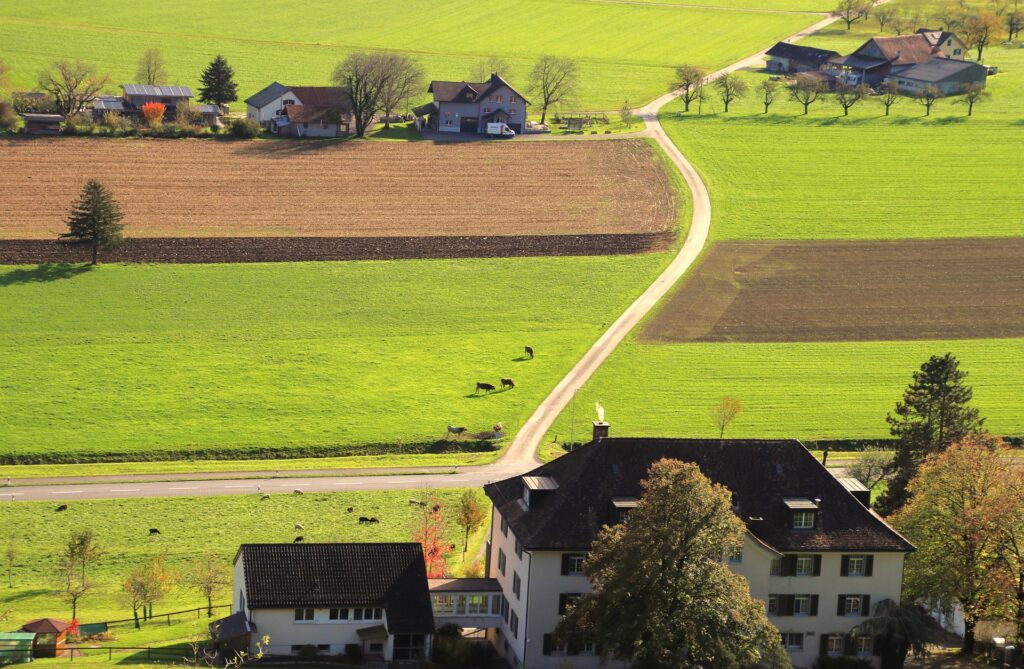Table of Contents
Introduction
In an era characterized by rapid urbanization, climate change, and a growing global population, the significance of farmland has never been more pronounced. Farmland is not merely a plot of land; it represents a vital resource that supports food production, sustains livelihoods, and contributes to the economy. For individuals seeking personal fulfillment and professional success, engaging with farmland whether through ownership, management, or agricultural careers—can be transformative.
This blog will delve into the multifaceted benefits of farmland, explore diverse career opportunities within farmland management, discuss the challenges faced by landowners and farmers, and highlight inspiring success stories from those who have thrived in this field. By the end of this article, you will understand why farmland is more than just land; it is a pathway to success.

Definition of Farmland
Farmland refers to land specifically used for agricultural purposes. It encompasses various types of land:
- Arable Land: This type of farmland is suitable for growing crops. It is characterized by fertile soil that can support various types of vegetation. Crops such as grains, vegetables, and fruits are typically grown on arable land.
- Pastureland: This land is primarily used for grazing livestock. It may include grasslands and other vegetation that provide fodder for animals. Pastureland management is crucial for maintaining healthy livestock and ensuring sustainable grazing practices.
- Orchards and Vineyards: Specialized farmland dedicated to growing fruit trees or grapevines. These areas require specific management practices to ensure healthy yields. For example, orchards may need regular pruning and pest control to maximize fruit production.
- Mixed-use Farms: Farms that combine crop production with livestock raising. This approach can enhance sustainability by utilizing resources more efficiently. For instance, livestock can provide manure that enriches the soil for crops.
Understanding these different types of farmland is essential for recognizing their unique contributions to agriculture and the economy.
Historical Context
The concept of farmland has evolved significantly over time. Historically, agriculture was the backbone of human civilization. Early societies relied on farming for sustenance, leading to the establishment of permanent settlements. As agricultural techniques advanced—such as crop rotation and selective breeding—farmland became increasingly productive.
In modern times, industrialization transformed agriculture with the introduction of machinery and chemical fertilizers. While these advancements increased productivity, they also led to environmental degradation and a decline in soil health. In response to these challenges, there has been a resurgence in interest in sustainable farming practices that prioritize ecological balance and long-term viability.
Current Trends in Farmland Use
Today, several trends are shaping the use and management of farmland:
- Sustainable Farming Practices: There is a growing emphasis on organic farming, permaculture, and regenerative agriculture—methods that focus on maintaining soil health and biodiversity while reducing chemical inputs.
- Agritourism: Many farmers are diversifying their income by offering agritourism experiences, such as farm stays or educational tours. This trend allows consumers to connect with food sources while providing additional revenue streams for farmers.
- Urban Agriculture: As cities expand, urban farming initiatives are gaining popularity. These projects utilize vacant lots or rooftops to grow food locally, reducing transportation costs and promoting community engagement.
- Technological Advancements: The integration of technology in farming practices—such as precision agriculture—allows farmers to optimize resource use and enhance productivity while minimizing environmental impact.
These trends highlight how farmland is evolving to meet the demands of a changing world while emphasizing sustainability and community involvement.
2: Benefits of Owning Farmland
Financial Stability
Owning farmland can provide significant financial benefits:
- Appreciation of Land Value: Farmland often appreciates over time due to its intrinsic value as a resource for food production. This appreciation can provide financial security for families across generations.
- Passive Income Opportunities: Farmland can be leased to other farmers or agricultural businesses, generating passive income without requiring active management. This arrangement allows landowners to benefit financially while supporting local agriculture.
- Diversification of Income Sources: Farmers can diversify their income by engaging in multiple agricultural activities—such as crop production, livestock raising, agritourism, or selling value-added products (like jams or cheeses).
Health and Lifestyle Advantages
Living or working on farmland offers numerous health benefits:
- Improved Mental Health: Studies have shown that spending time in nature can reduce stress and anxiety. The peaceful environment of rural areas contributes positively to mental well-being by providing a respite from urban noise and chaos.
- Physical Activity: Farming involves various physical activities—planting, harvesting, maintaining crops—which contribute to overall health and fitness. Engaging in regular physical activity helps maintain a healthy weight and reduces the risk of chronic diseases.
- Access to Fresh Produce: Owning farmland allows individuals to cultivate their own fruits and vegetables, promoting healthier eating habits while reducing reliance on industrial food systems filled with preservatives and additives.


Sustainable Living
Owning farmland provides opportunities for sustainable living:
- Environmental Stewardship: By practicing sustainable farming methods—such as organic farming or agroecology—landowners can contribute positively to environmental conservation efforts. These practices enhance soil health, preserve water quality, and support biodiversity.
- Community Engagement: Farmland often serves as a hub for community activities such as farmers’ markets or educational workshops about sustainable practices. Engaging with the community fosters connections among residents while promoting awareness about local food systems.
3: Career Opportunities in Farmland Management
The field of farmland management offers diverse career paths for individuals interested in agriculture:
Diverse Career Paths
- Farm Manager
- Responsible for overseeing daily operations on farms.
- Tasks include crop planning, labor management, budgeting, ensuring compliance with regulations.
- Requires strong leadership skills and knowledge of agricultural practices.
- Farm managers play a key role in implementing sustainable practices that enhance productivity while minimizing environmental impact.
- Agricultural Economist
- Analyzes economic trends affecting agriculture.
- Provides insights that inform policy decisions or business strategies.
- Requires strong analytical skills and knowledge of market dynamics.
- Agricultural economists help farmers make informed decisions about pricing strategies based on market conditions.
- Agronomist
- Focuses on improving crop production through research on soil management techniques.
- Works closely with farmers to optimize yields while minimizing environmental impact.
- Requires expertise in plant biology and soil science.
- Agronomists often conduct field trials to test new varieties or practices that enhance sustainability.
- Food Scientist
- Works on improving food safety standards while developing new products or processes within food manufacturing.
- Collaborates with farmers to ensure quality control from farm to table.
- Requires knowledge of food chemistry and processing techniques.
- Food scientists play an essential role in ensuring that products meet safety regulations while being nutritious.
- Environmental Consultant
- Advises agricultural businesses on sustainable practices that minimize environmental impact.
- Conducts assessments related to land use planning and conservation efforts.
- Requires knowledge of environmental regulations and sustainability principles.
- Environmental consultants help farms implement best practices that protect natural resources while maintaining productivity.
- Sustainable Agriculture Advocate
- Works with communities or organizations to promote sustainable agricultural practices through education and outreach programs.
- Engages with policymakers to influence agricultural policies toward sustainability.
- Requires strong communication skills and knowledge of sustainable agriculture principles.
- Advocates play a crucial role in raising awareness about the importance of eco-friendly farming methods among consumers and policymakers alike.


Education and Training Requirements
To pursue careers in farmland management:
- Degrees: Many universities offer undergraduate programs focused on agricultural sciences or business administration with concentrations related specifically towards agriculture.
- Certifications: Specialized certifications can enhance credentials—for example; obtaining certification from organizations like Certified Crop Adviser (CCA) demonstrates expertise within specific areas!
Investing time into gaining knowledge/experience prepares individuals well for future roles!
Skills Required for Success
To succeed in these roles requires specific skills:
- Financial Management: Understanding budgeting processes helps ensure profitability while managing resources effectively.
- Communication: Strong communication skills are essential for collaborating with diverse stakeholders—from farmers to consumers.
- Problem-Solving: The ability to think critically enables professionals tackle challenges that arise unexpectedly within their operations.
Developing these skills enhances employability while fostering career advancement opportunities!
4: Challenges in Farmland Ownership and Management
While owning or managing farmland offers numerous benefits, it also comes with challenges:
Market Challenges
Farmland management is a critical aspect of agriculture that involves overseeing the production of crops and livestock while ensuring sustainability and profitability. However, farmers and landowners face numerous market challenges that can significantly impact their operations.
Understanding these challenges is vital for anyone involved in agriculture or considering a career in farmland management. This section will explore the key market challenges affecting farmland management, including price volatility, input costs, regulatory issues, and the impact of external factors such as climate change and trade policies.
. Price Volatility
One of the most pressing challenges in farmland management is price volatility. Agricultural commodity prices can fluctuate dramatically due to various factors, including:
- Supply and Demand Imbalances: Changes in global supply and demand can lead to significant price swings. For instance, bumper crop yields may result in oversupply, driving prices down, while poor harvests due to adverse weather can lead to shortages and higher prices.
- Market Speculation: Commodity markets are often subject to speculation, where traders buy and sell based on anticipated future prices rather than actual supply and demand. This speculation can exacerbate price volatility, making it difficult for farmers to predict their income.
- Global Economic Conditions: Economic downturns or booms can affect consumer purchasing power and demand for agricultural products. For example, during economic recessions, consumers may reduce spending on premium products, impacting prices for organic or specialty crops.
According to recent reports, agricultural prices are projected to decrease by approximately 4% in 2025 due to oversupply and other market dynamics. This decline poses significant challenges for farmers who must navigate tight profit margins while managing production costs 14.
. Rising Input Costs
Farmers are also grappling with rising input costs that directly affect their profitability. Key inputs include:
- Fertilizers: The cost of fertilizers has surged in recent years due to increased demand and supply chain disruptions. Higher fertilizer prices can significantly impact crop production costs, leading to tighter profit margins for farmers.
- Labor Costs: Labor shortages have become a critical issue in agriculture, particularly as many farm workers are undocumented immigrants. Increased labor costs due to wage hikes or a shrinking workforce can strain farmers’ budgets.
- Equipment and Technology: The cost of agricultural machinery and technology has risen sharply. Farmers must invest in modern equipment to remain competitive, but these investments can be substantial and may not yield immediate returns.
The combination of high input costs and fluctuating commodity prices creates a challenging environment for farmland management. Farmers must carefully evaluate their production methods and input decisions to maximize returns on investment 23.


. Regulatory Issues
Navigating the complex landscape of agricultural regulations is another significant challenge for farmers:
- Environmental Regulations: Compliance with environmental regulations aimed at protecting soil health, water quality, and biodiversity can impose additional costs on farmers. Regulations related to pesticide use, nutrient management plans, and conservation practices require careful planning and investment.
- Trade Policies: Changes in trade policies can have profound effects on agricultural markets. For example, potential tariffs imposed by governments can increase costs for farmers who rely on imported goods or export their products abroad. The uncertainty surrounding trade agreements can also create instability in pricing.
- Certification Standards: Farmers seeking organic certification or compliance with other quality standards must adhere to strict guidelines that often require additional documentation and practices. While these certifications can open new markets, they also entail costs that may not be feasible for all producers 57.
. Climate Change Impacts
Climate change poses an existential threat to agriculture worldwide:
- Extreme Weather Events: Farmers are increasingly facing extreme weather events such as droughts, floods, and heatwaves that disrupt planting schedules and reduce crop yields. For instance, recent heatwaves have adversely affected major crops like maize and wheat in various regions 46.
- Changing Growing Seasons: Climate change is altering traditional growing seasons, making it challenging for farmers to predict when to plant or harvest crops effectively. This unpredictability can lead to reduced yields or crop failures.
- Pest and Disease Pressure: Warmer temperatures may also contribute to the proliferation of pests and diseases that threaten crops. Farmers must adapt their pest management strategies accordingly, which may require additional resources.
The interplay between climate change and agriculture creates a complex set of challenges that require innovative solutions from farmers 34.
. Global Trade Dynamics
Global trade dynamics significantly influence the agricultural sector:
- Strengthening U.S. Dollar: A strengthening U.S. dollar can make American-grown commodities more expensive for international buyers, potentially reducing exports. This scenario puts pressure on U.S. farmers who rely heavily on foreign markets for their products.
- Geopolitical Tensions: Trade disputes or geopolitical tensions between countries can disrupt supply chains and create uncertainty in agricultural markets. For example, tariffs imposed during trade wars can lead to retaliatory measures that further complicate international trade relationships
Regulatory Issues
The agricultural sector is subject regulatory scrutiny aimed at ensuring safety standards/protecting consumer interests! Navigating these regulations requires familiarity with local/national laws governing agriculture practices!Staying informed about changes within regulations allows businesses remain compliant while avoiding potential penalties associated non-compliance!
Sustainability Concerns
As environmental awareness grows; sustainability concerns have become paramount within agriculture! Professionals must address issues related resource depletion/pollution caused by conventional farming methods!Adopting sustainable practices such as regenerative agriculture promotes soil health while reducing negative impacts on ecosystems! Embracing these principles not only benefits our planet but also enhances long-term viability within this industry!


5: Success Stories in Farmland Management
Highlighting individuals who have made significant contributions within this field serves as inspiration for aspiring professionals! For example:
Case Studies of Successful Farmers
- Exploring the journeys of successful farmers provides valuable insights into effective agricultural practices, innovative approaches, and the resilience required to thrive in the farming sector. This section highlights several case studies that illustrate how farmers have overcome challenges, adopted sustainable practices, and achieved personal and professional success through their agricultural endeavors.
- 1. Will Allen – Urban Agriculture Pioneer
- Background: Will Allen is the founder of Growing Power, a nonprofit organization focused on urban agriculture. His work has transformed vacant urban spaces into productive farms that provide fresh produce while educating communities about sustainable practices.Key Practices:
- Aquaponics and Hydroponics: Allen utilizes aquaponics systems, which combine fish farming with vegetable cultivation. This method creates a symbiotic environment where fish waste provides nutrients for plants, and plants help filter and clean the water for fish.
- Community Engagement: Growing Power emphasizes community involvement by offering workshops and training programs for aspiring urban farmers. Allen’s approach fosters a sense of ownership among community members and encourages local food production.
- Impact: Through his innovative practices, Allen has not only provided fresh food to underserved communities but has also inspired countless individuals to engage in urban farming. His work highlights the potential of urban agriculture to address food deserts while promoting sustainability.
- 2. Chedlia – Embracing Intercropping
- Background: Chedlia is a farmer who adopted intercropping techniques to enhance her agricultural productivity. She initially faced challenges with traditional farming methods but decided to explore alternative practices.Key Practices:
- Intercropping: Chedlia grows multiple compatible crops on the same land, such as tomatoes, eggplants, and pulses. This method utilizes natural synergies between plants to improve yields and reduce pest infestations.
- Integrated Pest Management (IPM): By employing IPM strategies, she has successfully reduced pesticide use by half while maintaining crop quality. This approach not only lowers costs but also promotes environmental health.
- Impact: Chedlia’s decision to embrace intercropping resulted in increased income and improved soil health. Her success has motivated others in her village to adopt similar practices, demonstrating the power of innovation in traditional farming communities.
- 3. Rabindra – Organic Farming Advocate
- Background: Rabindra is a farmer who transitioned from conventional farming to organic practices after experiencing low yields and financial instability.Key Practices:
- Organic Certification: After receiving training on organic farming techniques, Rabindra began implementing practices such as vermicomposting, bio-pesticides, and crop rotation. His commitment to organic methods allowed him to achieve certification.
- Diversification of Crops: He diversified his crop production by growing various vegetables and fruits, which not only increased his income but also improved soil fertility through crop rotation.
- Impact: Rabindra’s shift to organic farming resulted in a significant increase in income—reportedly earning over Rs. 2.5 lakh annually from his diversified crops. His success serves as an inspiration for other farmers considering organic methods as a viable alternative.
- 4. Aum Zangmo – Integrated Farming Success
- Background: Aum Zangmo owns three acres of dryland and has been farming since childhood. After facing challenges with traditional crops like wheat and barley due to crop failures, she pivoted toward integrated farming.Key Practices:
- Diversified Crop Production: Aum Zangmo shifted her focus to horticultural crops such as potatoes, garlic, cabbage, and shiitake mushrooms. This diversification allowed her to mitigate risks associated with single-crop failures.
- Sustainable Practices: She utilizes oak tree logs as substrates for mushroom cultivation, which last for several years. This innovative practice not only provides a steady income but also promotes sustainable resource use.
- Impact: Aum Zangmo generates a net income of approximately Nu. 100,000 annually from her diverse crop production. Her success story illustrates how adaptability and diversification can lead to resilience in agriculture.
- 5. Jayaram Yadav – Technological Innovations
- Background: Jayaram Yadav is a farmer who adopted modern technological interventions recommended by Krishi Vigyan Kendra (KVK) for cultivating various crops.Key Practices:
- Precision Agriculture Techniques: Yadav implemented precision agriculture methods that optimize resource use while maximizing yields. These techniques include soil testing and targeted fertilization based on specific crop needs.
- Crop Diversification: He diversified his crop portfolio by growing high-value crops such as sugarcane, cotton, and horticultural products like mangoes and guavas.
- Impact: By embracing technology and diversifying his crops, Yadav achieved a net profit exceeding Rs. 2.5 lakh per year. His journey demonstrates the importance of innovation in enhancing productivity and profitability in farming.
These success stories illustrate how passion combined with innovation can lead transformative change within communities while contributing positively towards global food systems!
Lessons Learned from Their Journeys
Key takeaways from these journeys include:
- Embracing failure as part learning process encourages resilience!
- Fostering community engagement builds strong support networks essential navigating challenges successfully!
Conclusion
Engaging in farmland ownership or management represents a dynamic opportunity offering immense potential for personal fulfillment alongside professional success! From enhancing global food security addressing environmental concerns—this field encompasses numerous opportunities waiting exploration
!By actively participating within this industry individuals cultivate thriving careers rooted deeply within sustainable practices benefiting both themselves society at large!If you’re considering embarking your journey into farmland ownership or management—now is excellent time! Explore local resources available near you—whether workshops hosted experienced growers nearby online courses designed specifically around sustainable agricultural practices!
This detailed exploration provides an extensive overview of how engaging with farmland contributes significantly toward both personal fulfillment as well as professional success! Each section elaborates on various aspects related directly back toward understanding why this movement matters today more than ever before!